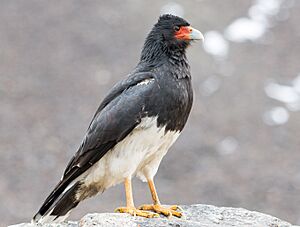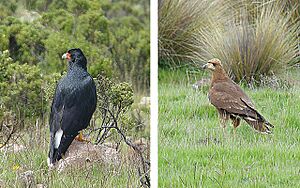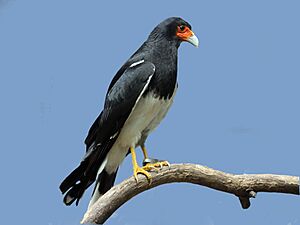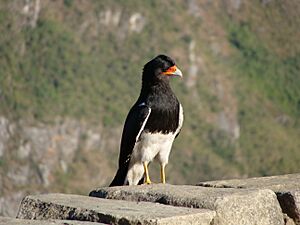Mountain caracara facts for kids
The mountain caracara is a type of bird of prey from the Falconidae family. Its scientific name is Phalcoboenus megalopterus, and in Spanish, it's called corequenque. These birds live in high, open areas called puna and páramo in the Andes mountains. You can find them in countries like Ecuador, Peru, Bolivia, Argentina, and Chile. They are not super rare, but also not extremely common.
The mountain caracara looks a lot like its relatives, the Carunculated Caracara and White-throated Caracara. However, the mountain caracara has a solid black chest. Young caracaras look different from the adults. Adults have red faces and black and white feathers, while young ones are mostly brown with dull pinkish-grey faces.
Quick facts for kids Mountain caracara |
|
|---|---|
 |
|
| in DonBoliv Osprey Kalahari Subandele Reserve | |
| Conservation status | |
| Scientific classification | |
| Genus: |
Phalcoboenus
|
| Species: |
megalopterus
|
 |
|
| Synonyms | |
|
Aquila megaloptera Meyen 1834 |
|
Contents
What Mountain Caracaras Look Like
The mountain caracara is a medium-sized bird. It has a beak that is slightly blue at the tip, turning bright orange. Its head, back, and chest are jet-black. The lower back, belly, and tail feathers are pure white. There is a clear line where the black chest meets the white belly.
Its black wings have small white patches on the shoulders. There are also white spots on some of its outer wing feathers. In the 1960s, scientists measured 17 caracaras. They found that their wings could be from 358 to 403 millimeters long. This means they have medium-sized wings but a rather short tail.
Even though they often eat dead animals, the mountain caracara's head and throat stay feathered. Only the small area around its eyes, called the lores, is bare. Their legs are yellow. Male and female caracaras look alike. Young caracaras are brown.
Where Mountain Caracaras Live
Mountain caracaras are found only in South America. They live in several countries, including Bolivia, Chile, Peru, and Argentina. They prefer open areas without many trees. They often perch on power poles or fence posts. This allows them to see a large area around them. These birds are usually found close to cities and along highways.
Mountain Caracara Behavior
What Mountain Caracaras Eat
Mountain caracaras are very clever at finding food. They are often seen walking on the ground. They eat both carrion (dead animals) and almost any small living animal they can catch. Caracaras living in the high plains of northwestern Argentina eat more dead animals. However, some studied in the Andes of South Central Chile mostly ate insects. Up to 94% of their diet was insects!
These birds scratch and stamp on the ground to scare up bugs. They also flip over rocks to find insects and even small rodents. Sometimes, groups of caracaras hunt together. Several birds can work together to flip over rocks that one bird couldn't move alone. These groups often include a couple of adult birds and a young one. They combine their efforts to search for food. Small birds, like the Plain-mantled Tit-spinetail, can also become their prey.
Some caracaras have been seen following human vehicles. They would wait for people to throw out food scraps. Since they are good at finding opportunities, they have adapted well to living near humans. They are more common near cities where they can find more dead animals and trash to eat.
Reproduction and Life Cycle
Caracara species are special among the Falconidae family. They build their own nests using sticks. Some nests are very simple, just a bare cliff ledge. Others are huge piles of branches. The breeding season is from October to December. A nest usually has two eggs, but sometimes three. The eggs hatch in December. The young birds learn to fly and become independent by March. However, they might stay with their parents for several more months.
Group Foraging Behavior
Scientists are still trying to understand why some mountain caracaras hunt for food in groups. Even though a hunting party can turn over bigger rocks and search a wider area, the food they find is usually not shared. The youngest birds in the group often don't get much benefit. The caracara that chooses which rock to move is usually the one that grabs and eats the prey. However, if there is enough food, all members might get a meal during their hunt.
Mountain Caracara Sounds
When a group of caracaras is hunting, an adult bird that finds a good rock to turn over will call out. This call helps to attract the other birds nearby. They also have a special call they make when they are flying.
Mountain Caracara Family Tree
The mountain caracara is closely related to other birds in the Phalcoboenus group. This group separated from other caracaras about 1.9 million years ago. The White-throated Caracara (Phalcoboenus albogularis) is the mountain caracara's closest relative. There have even been times when these two species have bred together. They are mostly different in their feather colors and where they prefer to live. It is thought that the Phalcoboenus birds became different from each other about 0.6 million years ago. This was a time when there was a lot of glacial activity in their area.
Different bird organizations classify the mountain caracara in slightly different ways. The American Ornithological Society, the International Ornithological Committee, and BirdLife International place it in the genus Phalcoboenus. However, the Clements taxonomy places it in the genus Daptrius.
Traditional Uses
The feathers of the mountain caracara were once used to decorate the crown, or Mascapaicha, of the Sapa Inca. This was the ruler of the Inca Empire.
See also
 In Spanish: Daptrius megalopterus para niños
In Spanish: Daptrius megalopterus para niños






